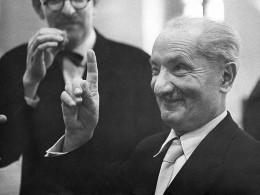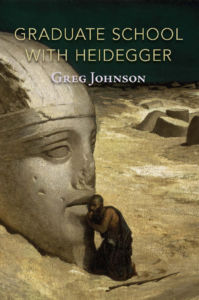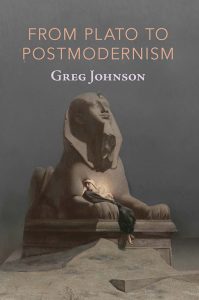Heidegger without Being
Posted By Greg Johnson On In North American New Right | Comments Disabled 2,101 words
2,101 words
The following brief introduction to Martin Heidegger’s philosophy does not discuss the concept of Being (Sein), simply because there’s no need to.
When understanding Heidegger, everything flows from the distinction between acts of consciousness and objects of consciousness. Acts of consciousness are what we do to know things. Objects of consciousness are the things we know. I see food and utensils on the kitchen counter, feel the knife in my hand, hear the sound of chopping, smell onions and rosemary, and taste the broth to see if it needs salt. I wonder when the guests will start arriving, glance at the clock to see the time, and ruefully recall the one with a history of lateness.
Every act of consciousness is directed toward an object of consciousness. This relationship is called intentionality, and specific acts of consciousness are called intentions. Intentionality does not mean “doing things on purpose,” and in this context, intentions don’t mean the motives or goals of action. Intentionality is the object-directedness of consciousness.
There are two basic kinds of intentions: filled and empty. An intention is filled when its object is present. When I turn for a knife, my intention is filled by the knife itself. By contrast, an empty intention is not filled by the presence of its object. Instead, it encounters the absence of its object. I open a drawer to find the vegetable peeler and discover its absence.
Our consciousness is a complex interplay of filled and empty intentions, of presence and absence.
 [1]
[1]You can buy Greg Johnson’s Graduate School with Heidegger here [2]
But there’s more to showing up than just being present. Even present objects are partially absent. When I look at the knife on the counter, the top side is present, and the underside is absent. But I see the same knife in its presence and absence. If I flip the knife over, the present side becomes absent, and the absent side becomes present. But the knife remains the same. Things show up through an interplay of presence and absence. We encounter them through an interplay of empty and filled intentions.
If the things in the world are never fully present, what about the self? There is nothing closer than our selves. Surely our selves are fully present.
Let’s think this through. When I look at the knife, hear and smell butter sizzling in the pan, and rummage around for the vegetable peeler, these objects are present or absent. But I am not present. I am not focused on myself. I am focused on things other than myself. Moreover, if I were focused on myself, I would not be focused on the things around me. They would still be happening, of course. Smells and sounds and sights would still be bombarding me. But my attention would be focused inward, on myself. When I make myself present, the things around me become—relatively speaking, at least—absent, or I become absent-minded toward them. I could, of course, focus back outward at any time, and I might be jolted into doing so, for instance if the pan began smoking and the fire alarm went off.
To understand what is going on here, we need to make a distinction between focal awareness and marginal awareness. When we are focally aware of an object, we retain a marginal awareness of other objects. We can also switch our focus, making the margin the new center of our attention, while the former center becomes the new margin. Because we are simultaneously focally and marginally aware, the mind can be in many places at the same time. But the mind cannot be focally in two places at the same time. In order to focus on the world around us, we must not focus on ourselves. For the world to be present, the self must be absent.
But what if we set the world aside entirely and just focus on the self? Can the self be fully present to itself, fully transparent to itself?
 [3]
[3]You can buy Jef Costello’s Heidegger in Chicago here [4]
Let’s think this through. When we reflect on ourselves, we are taking the distinction between acts of consciousness and objects of consciousness “indoors,” into the realm of consciousness itself. When I reflect on what happens when I find the vegetable peeler absent, I am turning an act of consciousness into an object of consciousness. But an act of consciousness can be objectified only by another act of consciousness. Consciousness can split itself in two, into an inner act and an inner object. And the inner act of consciousness can only do its job by being an act, which means that it will remain absent to us. We look through our acts of consciousness to their objects. When the act itself becomes present, the object becomes absent. Acts of consciousness can only do their jobs by not getting in the way—i.e., not becoming objects—by remaining as unobtrusive and undistracting as possible.
If reflection splits consciousness into an inner act and an inner object, then reflecting upon reflection itself requires a similar split. We have moved from cooking, to reflecting upon our awareness of cooking, to reflecting upon reflection itself. But reflection can be the object of a meta-reflection only if that act itself remains absent. This process can be repeated again and again—reflection upon reflection upon reflection, ad infinitum—but the distinction between act and object will always remain, and every act qua act will always remain absent. Thus consciousness can never be fully present to itself.
Consciousness is ultimately an activity, and as an activity, it can never be an object. When conscious acts are objectified, they are in effect dead. But a living act can never be an object. It is a blur, like the kingfisher in flight. You can try to grab the snake of consciousness, but it always slithers away, leaving its dead skin behind. Thus any attempt to speak about consciousness as merely an object is always inadequate.
Heidegger called the ultimate non-objectifiability of conscious life our “facticity.” But doesn’t talking about the non-objectifiable make it into an object? Yes and no. Yes, because everything we talk about is in some sense an object. No, because not everything we talk about is a well-defined, present object. Language can also point to absences and mysteries and blurs.
Heidegger invented the term “formal indication” for non-objectifying discourse about human beings. In Being and Time, he coins the term “existentials” to describe ways of speaking about human beings, reserving the Aristotelian “categories” to describe ways of speaking about things. From his earliest writings to the end of his career, Heidegger was focused on trying to find non-objectifying ways of talking about the human realm, which is one reason his work is so difficult to understand.
 [5]
[5]You can buy Greg Johnson’s From Plato to Postmodernism here [6]
Thus far, our discussion of human consciousness has seemingly been entirely abstract and universalist, applicable to any man, anytime, anywhere. But that’s not really true. I am writing this in English, my mother tongue. You are reading this in English, but for many of you, English is not your mother tongue. As soon as we learn to speak, our consciousness is bound up with language. Although the ability to speak is a universal trait of human nature, languages are not universal and natural. There are many different human languages, which vary from time to time and place to place.
If language is not natural, is it conventional, i.e., something devised as a medium of communication, like traffic signals, in which green stands for go and red stands for stop? Language isn’t really conventional in this way, because to create conventions, we would need to talk about why we need them, what stands for what, how to implement them, etc. Which means that creating conventions presupposes the existence of a language. Therefore, language is not merely conventional.
Yet language cannot exist without mankind. We can, moreover, coin new terms and create conventions that become part of language. But for Heidegger, we cannot ultimately understand, create, or control language. Language is a practice that allows us to make things present. It is an activity of consciousness. Like all activities of consciousness, language can be reflected upon—but when it is active and alive, in the moment, it is absent. As an activity of consciousness, language is ultimately non-objectifiable.
Moreover, like all other meaningful social practices, we learn language by imitation before we are capable of self-consciousness and critical thinking. Languages and other social practices are traditions, passed down from time out of mind. Language may even be older than man, since we may have learned languages and other practices from our pre-human ancestors. Thus, at the core of the practices by which we make sense of the world, there is an unobjectifiable mystery that transcends each individual mind, merging us into myriad collective traditions that fade into the mists of unrecorded history.
 [7]
[7]You can buy Collin Cleary’sWhat is a Rune?, featuring extensive discussions of Heidegger, here [8]
Heidegger uses the word “humanism” for the idea that language and other meaningful human practices can be constructed and controlled by human consciousness. Heidegger is an anti-humanist, because he thinks it is closer to the truth that language, culture, and history construct the human mind rather than the human mind constructs language, culture, and history.
This is important, because from Ancient Greece to the present day, our civilization has been in the grip of diametrically opposed views of knowledge and power. When Plato denigrated sense experience and received opinion and claimed that true reality consists of unchanging “forms,” or when Descartes discarded sense experience and tradition until he arrived at an unshakeable foundation (“I think, therefore I am”), they were defining the real as that which satisfied their desire for certitude, which was based ultimately in a desire for power. They were “humanists” because they defined reality as what satisfies human desires. This drive culminated in modern scientific and technological civilization, which defines the real as what is susceptible to scientific understanding and available for manipulation, control, and consumption.
Humanism is a profoundly self-alienating and self-destructive worldview, since it uproots us from the plurality of languages and cultures that give us meaning. It also abolishes all sense of limits to human knowledge and power—the whole dimension of absence, i.e., what escapes our knowledge and power. Humanism severs us from meaning and measure.
By destroying meaning, humanism condemns us to nihilism. By denying measure, humanism delivers us over to the unbounded pursuit of technological mastery over nature. I am going to call the complex of humanism, technology, and nihilism modernity, for short. The end result of modernity is the dehumanization of man and the devastation of the earth.
How, then, can we overcome modernity? Can we lay bare its roots, plan out an alternative, and then put that plan into action? Obviously, such a solution presupposes that we can understand and engineer human history—which is the very modernist delusion we seek to supplant. One can’t fight humanism with more humanism. One can’t fight modernity with more modernity. The solution to nihilism is not intensified nihilism. This is the lesson that Heidegger drew from his political involvement in the 1930s.
Heidegger’s later philosophy is essentially a theory of historical change. As an anti-humanist, Heidegger does not think that human minds create history. Instead, history creates human minds. Modernity was not thought up by Plato, Descartes, and Nietzsche. Philosophers are not the hidden legislators of mankind. But they often offer the earliest and deepest articulations of fundamental changes in the Zeitgeist. To express the idea of historical change without an agent behind it, Heidegger uses the word “event” (Ereignis). The event refers specifically to fundamental transformations of the meaning of everything, such as the emergence of modernity—or its replacement with something else.
Modernists think they can understand and control history, but they can’t even understand or control the emergence of modernity, which remains a mystery. Modernity wasn’t thought up by modernists. Modernity wasn’t imposed by modernists. Modernity is simply an event in the Zeitgeist that emerged from the inscrutable wellspring of meaning and has enthralled us.
But if modernity was not created and imposed by humans, then an alternative to modernity cannot emerge that way either. Anti-modernists need not despair, however, for if Heidegger is right about historical change, then our discontent with modernity is not merely subjective. We too are responding to a change in the Zeitgeist. There’s nothing to prevent us from unplugging as much as we can from modernity, but we don’t have to do the impossible to create a better world, for the change that we dream of is, in a sense, already real, and it is coming to meet us.
If you want to support Counter-Currents, please send us a donation by going to our Entropy page [9] and selecting “send paid chat.” Entropy allows you to donate any amount from $3 and up. All comments will be read and discussed in the next episode of Counter-Currents Radio, which airs every Friday.
Don’t forget to sign up [10] for the twice-monthly email Counter-Currents Newsletter for exclusive content, offers, and news.